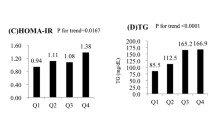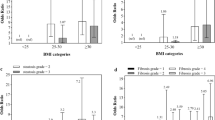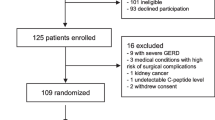Abstract
Introduction
Nonalcoholic fatty liver disease (NAFLD) is the liver manifestation of adiposopathy. Recently, a new score was developed to estimate body fat percentage (relative fat mass, RFM). We aimed to evaluate the value of RFM in predicting the presence and severity of NAFLD, compared with other anthropometric measurements.
Methods
RFM, body mass index (BMI), and other anthropometric measurements were evaluated in two cohorts of subjects: a cohort from a Portuguese prospective epidemiological study (e_Cor) and morbidly obese patients with biopsy-proven NAFLD. We evaluated if RFM and BMI were related with the presence and severity of liver disease, which was assessed by noninvasive tools in the first cohort and by liver histology in the morbidly obese cohort. The independence of relations found in univariate analysis was assessed with multivariable logistic regression analysis.
Results
In the general population cohort, 744 subjects (48% male) were enrolled. BMI-defined obesity was present in 23% and RFM-defined obesity in 86%. Insulin resistance (IR) related with BMI-defined obesity (OR 4.37 [2.16–8.84]) and weight (OR 1.05 [1.02–1.08]) in men, and waist circumference (WC) (OR 1.07 [1.03–1.11]) in women. Dyslipidemia and hypertension related with RFM-defined obesity in men (OR 2.96 [1.36–6.47] and OR 5.37 [1.31–22.06], respectively). Ultrasound-diagnosed NAFLD in 33% related with weight in men (OR 1.03 [1.003–1.06] and WC in women (OR 1.06 [1.02–1.10]). In men, ALT elevation related with weight (OR 1.04 [1.02–1.07]). In women, advanced fibrosis (estimated by NAFLD Fibrosis Score) associated with BMI-defined obesity (OR 42.43 [3.61–498.13]). In the morbidly obese cohort, 152 subjects were enrolled, of whom 84% were female, 37% had steatohepatitis, and 9.4% had advanced fibrosis. Adiponectin associated inversely and leptin positively with RFM in men. The severity of steatosis increased linearly with BMI and WC in women. Higher BMI associated with steatohepatitis in women and advanced fibrosis in men.
Conclusion
RFM-defined obesity better predicted dyslipidemia and hypertension (though not IR) and adipokine imbalance; however, it did not add value to BMI-defined obesity in predicting NAFLD or liver injury.

Similar content being viewed by others
Abbreviations
- ALT:
-
Alanine aminotransferase
- BMI:
-
Body mass index
- DXA:
-
Dual-energy X-ray absorptiometry
- ELISA:
-
Enzyme-linked immunosorbent assay
- HOMA-IR:
-
Homeostasis model assessment of insulin resistance
- IR:
-
Insulin resistance
- NAFLD:
-
Nonalcoholic fatty liver disease
- RFM:
-
Relative fat mass
- WC:
-
Waist circumference
References
Estes C, Anstee QM, Arias-Loste MT, et al. Modeling NAFLD disease burden in China, France, Germany, Italy, Japan, Spain, United Kingdom, and United States for the period 2016-2030. J Hepatol. 2018;69(4):896–904.
Machado MV, Diehl AM. Pathogenesis of nonalcoholic steatohepatitis. Gastroenterology. 2016;150(8):1769–77.
Li L, Liu DW, Yan HY, et al. Obesity is an independent risk factor for non-alcoholic fatty liver disease: evidence from a meta-analysis of 21 cohort studies. Obes Rev. 2016;17(6):510–9.
Non-alcoholic Fatty Liver Disease Study G, Lonardo A, Bellentani S, et al. Epidemiological modifiers of non-alcoholic fatty liver disease: focus on high-risk groups. Dig Liver Dis. 2015;47(12):997–1006.
Ryan DH, Kahan S. Guideline recommendations for obesity management. Med Clin North Am. 2018;102(1):49–63.
Sharma AM, Campbell-Scherer DL. Redefining obesity: beyond the numbers. Obesity (Silver Spring). 2017;25(4):660–1.
Garvey WT, Mechanick JI, Brett EM, et al. American Association of Clinical Endocrinologists and American College of Endocrinology comprehensive clinical practice guidelines for medical care of patients with obesity. Endocr Pract. 2016;22(Suppl 3):1–203.
Woolcott OO, Bergman RN. Relative fat mass (RFM) as a new estimator of whole-body fat percentage horizontal line. A cross-sectional study in American adult individuals. Sci Rep. 2018;8(1):10980.
Carvalhana SC, Leitao J, Alves AC, et al. Hepatitis B and C prevalence in Portugal: disparity between the general population and high-risk groups. Eur J Gastroenterol Hepatol. 2016;28(6):640–4.
Matthews DR, Hosker JP, Rudenski AS, et al. Homeostasis model assessment: insulin resistance and beta-cell function from fasting plasma glucose and insulin concentrations in man. Diabetologia. 1985;28(7):412–9.
Marchesini G, Bugianesi E, Forlani G, et al. Nonalcoholic fatty liver, steatohepatitis, and the metabolic syndrome. Hepatology. 2003;37(4):917–23.
Genuth S, Alberti KG, Bennett P, et al. Follow-up report on the diagnosis of diabetes mellitus. Diabetes Care. 2003;26(11):3160–7.
National High Blood Pressure Education Program Working Group report on primary prevention of hypertension. Arch Intern Med. 1993;153(2):186–208.
Kleiner DE, Brunt EM, Van Natta M, et al. Design and validation of a histological scoring system for nonalcoholic fatty liver disease. Hepatology. 2005;41(6):1313–21.
Younossi ZM, Stepanova M, Rafiq N, et al. Pathologic criteria for nonalcoholic steatohepatitis: interprotocol agreement and ability to predict liver-related mortality. Hepatology. 2011;53(6):1874–82.
Angulo P, Hui JM, Marchesini G, et al. The NAFLD fibrosis score: a noninvasive system that identifies liver fibrosis in patients with NAFLD. Hepatology. 2007;45(4):846–54.
Kabir M, Catalano KJ, Ananthnarayan S, et al. Molecular evidence supporting the portal theory: a causative link between visceral adiposity and hepatic insulin resistance. Am J Physiol Endocrinol Metab. 2005;288(2):E454–61.
Pang Q, Zhang JY, Song SD, et al. Central obesity and nonalcoholic fatty liver disease risk after adjusting for body mass index. World J Gastroenterol. 2015;21(5):1650–62.
Wu P, Hua Y, Tan S, et al. Interactions of central obesity with rs3918242 on risk of non-alcoholic fat liver disease: a preliminary case-control study. Int J Clin Exp Pathol. 2015;8(4):4165–70.
Wajchenberg BL, Giannella-Neto D, da Silva ME, et al. Depot-specific hormonal characteristics of subcutaneous and visceral adipose tissue and their relation to the metabolic syndrome. Horm Metab Res. 2002;34(11-12):616–21.
Tison GH, Blaha MJ, Nasir K, et al. Relation of anthropometric obesity and computed tomography measured nonalcoholic fatty liver disease (from the Multiethnic Study of Atherosclerosis). Am J Cardiol. 2015;116(4):541–6.
Ostovaneh MR, Zamani F, Ansari-Moghaddam A, et al. Nonalcoholic fatty liver: the association with metabolic abnormalities, body mass index and central obesity--a population-based study. Metab Syndr Relat Disord. 2015;13(7):304–11.
Wong RJ, Ahmed A. Obesity and non-alcoholic fatty liver disease: disparate associations among Asian populations. World J Hepatol. 2014;6(5):263–73.
Palmer BF, Clegg DJ. The sexual dimorphism of obesity. Mol Cell Endocrinol. 2015;402:113–9.
Yang KC, Hung HF, Lu CW, et al. Association of non-alcoholic fatty liver disease with metabolic syndrome independently of central obesity and insulin resistance. Sci Rep. 2016;6:27034.
Sun K, Kusminski CM, Scherer PE. Adipose tissue remodeling and obesity. J Clin Invest. 2011;121(6):2094–101.
Kloting N, Bluher M. Adipocyte dysfunction, inflammation and metabolic syndrome. Rev Endocr Metab Disord. 2014;15(4):277–87.
Petaja EM, Sevastianova K, Hakkarainen A, et al. Adipocyte size is associated with NAFLD independent of obesity, fat distribution, and PNPLA3 genotype. Obesity (Silver Spring). 2013;21(6):1174–9.
Wree A, Schlattjan M, Bechmann LP, et al. Adipocyte cell size, free fatty acids and apolipoproteins are associated with non-alcoholic liver injury progression in severely obese patients. Metabolism. 2014;63(12):1542–52.
du Plessis J, van Pelt J, Korf H, et al. Association of adipose tissue inflammation with histologic severity of nonalcoholic fatty liver disease. Gastroenterology. 2015;149(3):635–48. e14
Author information
Authors and Affiliations
Corresponding author
Ethics declarations
Conflict of Interest
The authors declare that they have no conflict of interest.
Ethical Approval
The study was approved by the Hospital Santa Maria Human Ethics Committee. The study protocol conformed to the ethical guidelines of the 1975 Declaration of Helsinki, revised in 2000.
Statement of Informed Consent
Informed consent was obtained from all individual participants included in the study.
Additional information
Publisher’s Note
Springer Nature remains neutral with regard to jurisdictional claims in published maps and institutional affiliations.
Rights and permissions
About this article
Cite this article
Machado, M.V., Policarpo, S., Coutinho, J. et al. What Is the Role of the New Index Relative Fat Mass (RFM) in the Assessment of Nonalcoholic Fatty Liver Disease (NAFLD)?. OBES SURG 30, 560–568 (2020). https://doi.org/10.1007/s11695-019-04213-8
Published:
Issue Date:
DOI: https://doi.org/10.1007/s11695-019-04213-8




